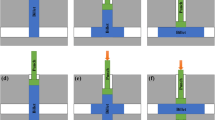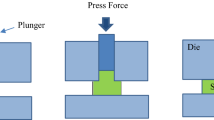Abstract
A geometric model is proposed which describes specific features of the displacement and distortion of the end regions of the samples upon equal-channel angular pressing (ECAP). It is shown that, upon some ECAP, the volume occupied by the end regions can be relatively large. In such cases, the arising structure will be characterized by a substantial inhomogeneity, especially in relatively short samples or when using a small number of ECAP passes.
Similar content being viewed by others
References
V. M. Segal, V. I. Reznikov, V. I. Kopylov, et al., Processes of Plastic Structure Formation in Metals (Nauka i Tekhnika, Minsk, 1994) [in Russian].
R. Z. Valiev, R. K. Islamgaliev, and I. V. Alexandrov, “Bulk Nanostructured Materials from Severe Plastic Deformation,” Prog. Mater. Sci. 45(10), 103–189 (2000).
P. B. Prangnell, C. Harris, and S. M. Roberts, “Finite Element Modeling of Equal Channel Angular Extrusion,” Scr. Mater. 17(2), 983–989 (1997).
H. S. Kim, J. Y. Soh, and J. W. Park, “Analysis of Deformation Behavior in Equal-Channel Angular Pressing,” J. Korean. Inst. Met. Mater. 37(9), 1064–1068 (1999).
N. M. Rusin, “A Mold for Equal-Channel Angular Pressing of Materials,” RF Patent No. 2221697.
N. M. Rusin, “A Device for Briquetting Powder and Granulated Materials,” RF Patent No. 34450.
Y. Iwahashi, M. Furukawa, Z. Horita, et al., “Structural Characteristics of Ultrafine-Grained Aluminum Produced Using Equal-Channel Angular Pressing,” Metal. Mater. Trans. A 29A, 2245–2252 (1998).
V. M. Segal, “Equal Channel Angular Extrusion: From Macromechanics to Structure Formation,” Mater. Sci. Eng., A 271, 322–333 (1999).
N. M. Rusin and K. V. Vishnyakov, “Deformation Distribution in Samples upon Equal Channel Angular Extrusion,” in Proceedings of V All-Russia Conference (School) of Young Scientists (Tomsk, 2003), pp. 97–98.
Author information
Authors and Affiliations
Additional information
Original Russian Text © N.M. Rusin, 2006, published in Fizika Metallov i Metallovedenie, 2006, Vol. 102, No. 2, pp. 242–249.
Rights and permissions
About this article
Cite this article
Rusin, N.M. Effect of ECAP routes on the specific features of the “end effect”. Phys. Metals Metallogr. 102, 226–232 (2006). https://doi.org/10.1134/S0031918X06080151
Received:
Accepted:
Issue Date:
DOI: https://doi.org/10.1134/S0031918X06080151




